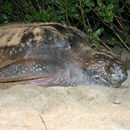Biology
provided by Arkive
Adult leatherbacks feed mainly on jellyfish and other soft-bodied species (9). They are exceptional amongst reptiles because they are partly able to maintain an elevated body temperature via thermal inertia and a specially organized blood supply system in their shoulders (10). These features allow leatherback turtles to travel to cold waters and to dive to depths greater than 1,000 meters in search of prey (11).
To nest, females emerge at night on nesting beaches to lay their eggs. Using their rear flippers they excavate deep 'boot shaped' nests into which roughly 100 eggs are laid. Around 20 percent of the eggs in each nest are small and yolkless (2). Individuals return to nest every few years, but within one season a female can lay four to ten clutches of eggs (2). The sex of the hatchlings is influenced by incubation temperatures: hotter nests produce all females; cooler nests produce all males (12).
Conservation
provided by Arkive
International trade in leatherback turtles and products is banned under Appendix I of the Convention on International Trade in Endangered Species (CITES), and the turtle is protected throughout most of its range (1). Many conservation projects have been set up on nesting beaches, with specific management protocols tailored to each location. The attachment of Turtle Excluding Devices (TEDs) to shrimp nets can help prevent the accidental capture of turtles (bycatch) and the US government has recently set up Leatherback Conservation Areas in the north Pacific that are off-limits to long-line fisheries during certain times of the year. Despite encouraging signs of stable or increasing populations in the Atlantic, conservationists are concerned that extinction of other populations is only a matter of time. Recent estimates have suggested there are no more than 2000 breeding females in the eastern Pacific, making this population extremely vulnerable (12).
Description
provided by Arkive
The leatherback is the world's largest turtle; the largest recorded individual weighed a massive 916 kilograms (5). This turtle earned its common name because it lacks the typical bony plates on its carapace. Instead, its shell is flexible and covered in a thin layer of leathery skin. This turtle is dark in colour with white and pink spots. Leatherbacks are easily recognisable by the seven narrow ridges running the length of the carapace, and by their particularly large front flippers. Females also have a characteristic 'pink spot' on the top of their heads (6).
Habitat
provided by Arkive
Adults are truly pelagic; they are strong swimmers inhabiting the open seas. Mature females prefer to nest on sandy tropical beaches with deep-water approaches, although shallow water beaches are also used in certain regions. Very little is known about juvenile leatherbacks in the ocean, although recently some small individuals have been found concentrated in waters off western Africa (8).
Range
provided by Arkive
Found throughout the world's oceans with the widest distribution of all the turtles, the leatherback has been recorded as far north as Alaska and as far south as the tip of South Africa (1). These turtles often undertake long-distance migrations, between feeding grounds in temperate waters and nesting beaches in the tropics, sometimes surpassing 7,000 kilometres over several months (7).
Status
provided by Arkive
Classified as Critically Endangered (CR) on the IUCN Red List 2007 (1). Listed on Appendix I of CITES (3) and Appendix I of the Convention on Migratory Species (CMS or the Bonn Convention) (4).
Threats
provided by Arkive
Several populations of leatherback turtles in the Pacific have plummeted in recent years, principally due to accidental capture in fisheries and the over-harvest of eggs (13). Other threats to leatherbacks worldwide include habitat loss, accidental capture in fisheries, boat strikes, and ingestion of discarded plastics, which leatherbacks mistake for jellyfish (14).

